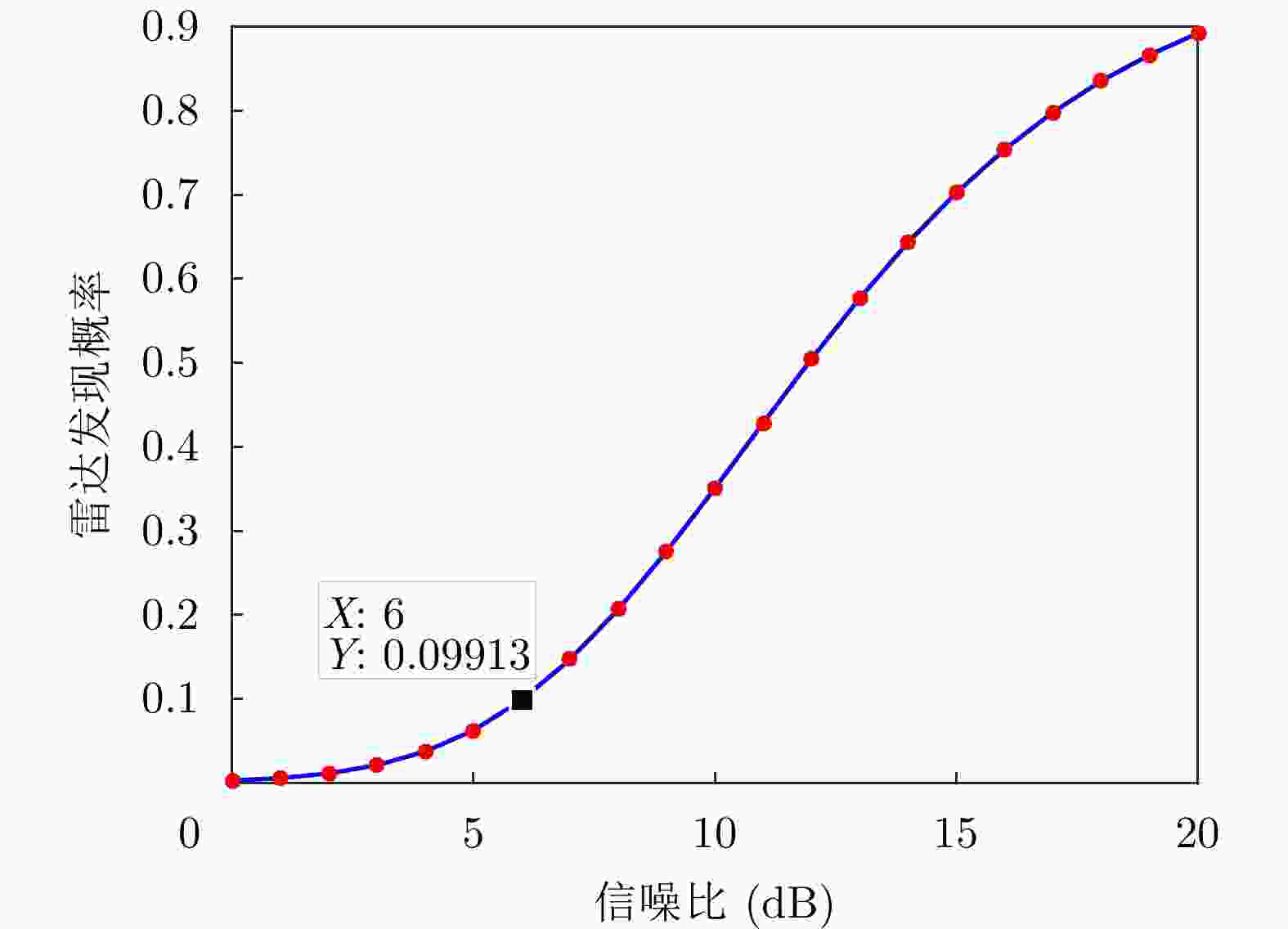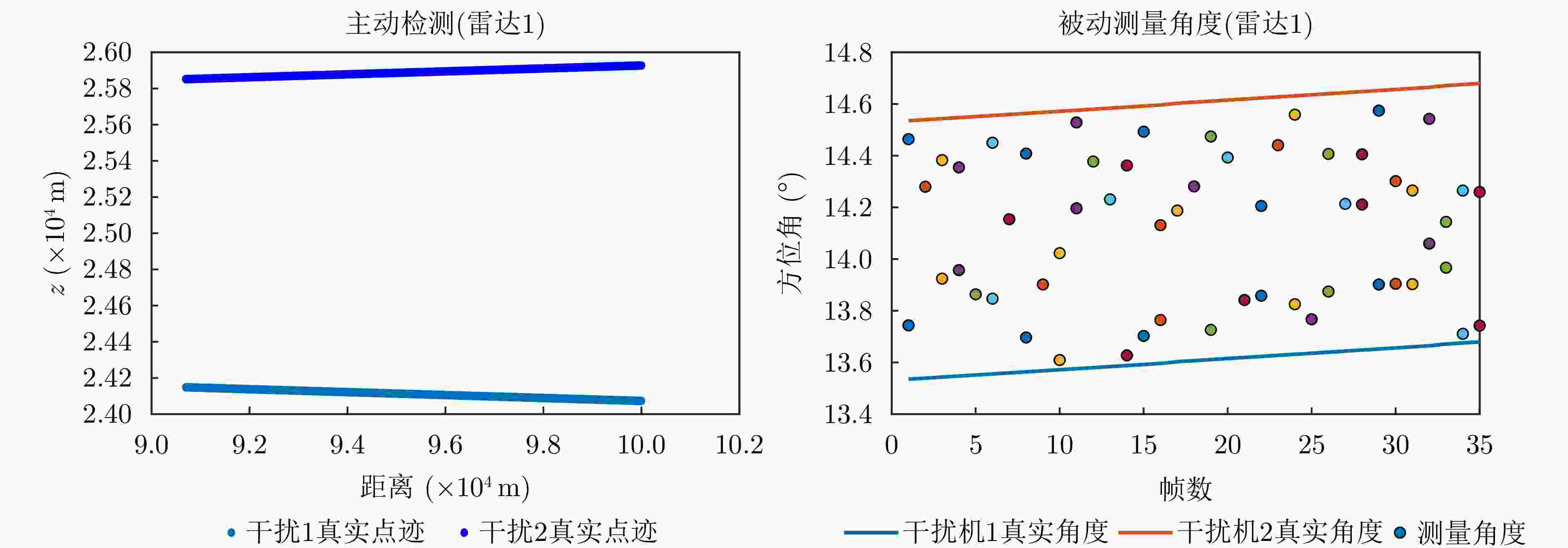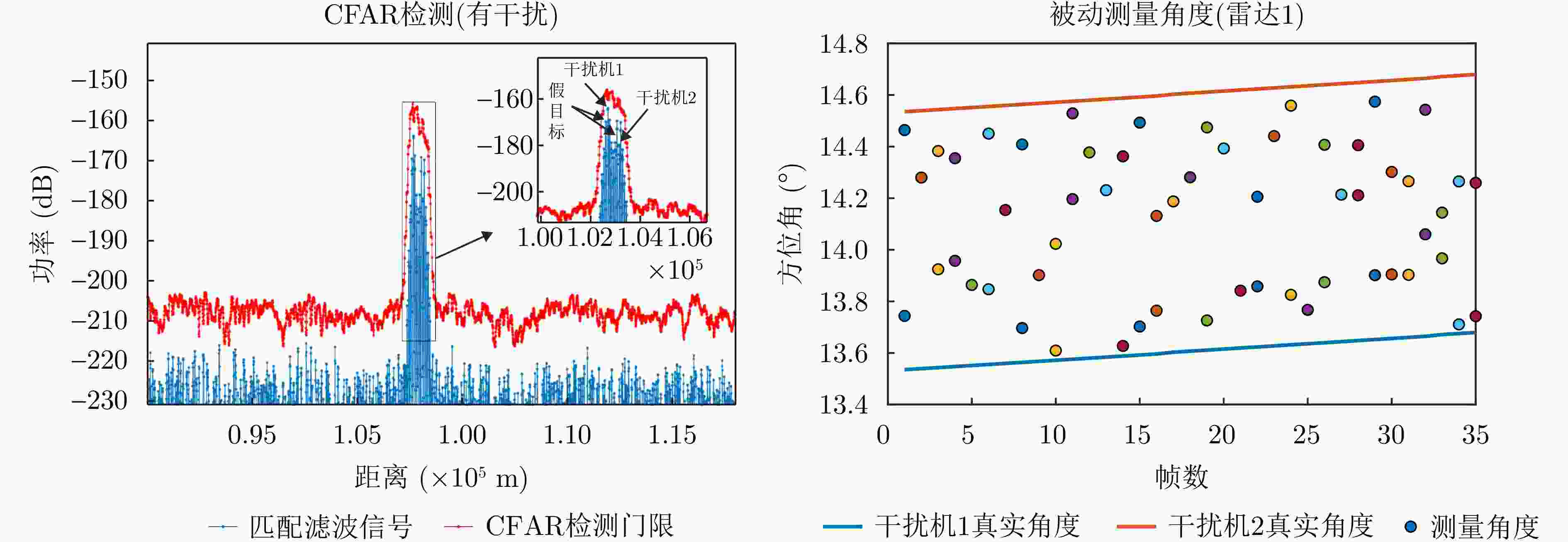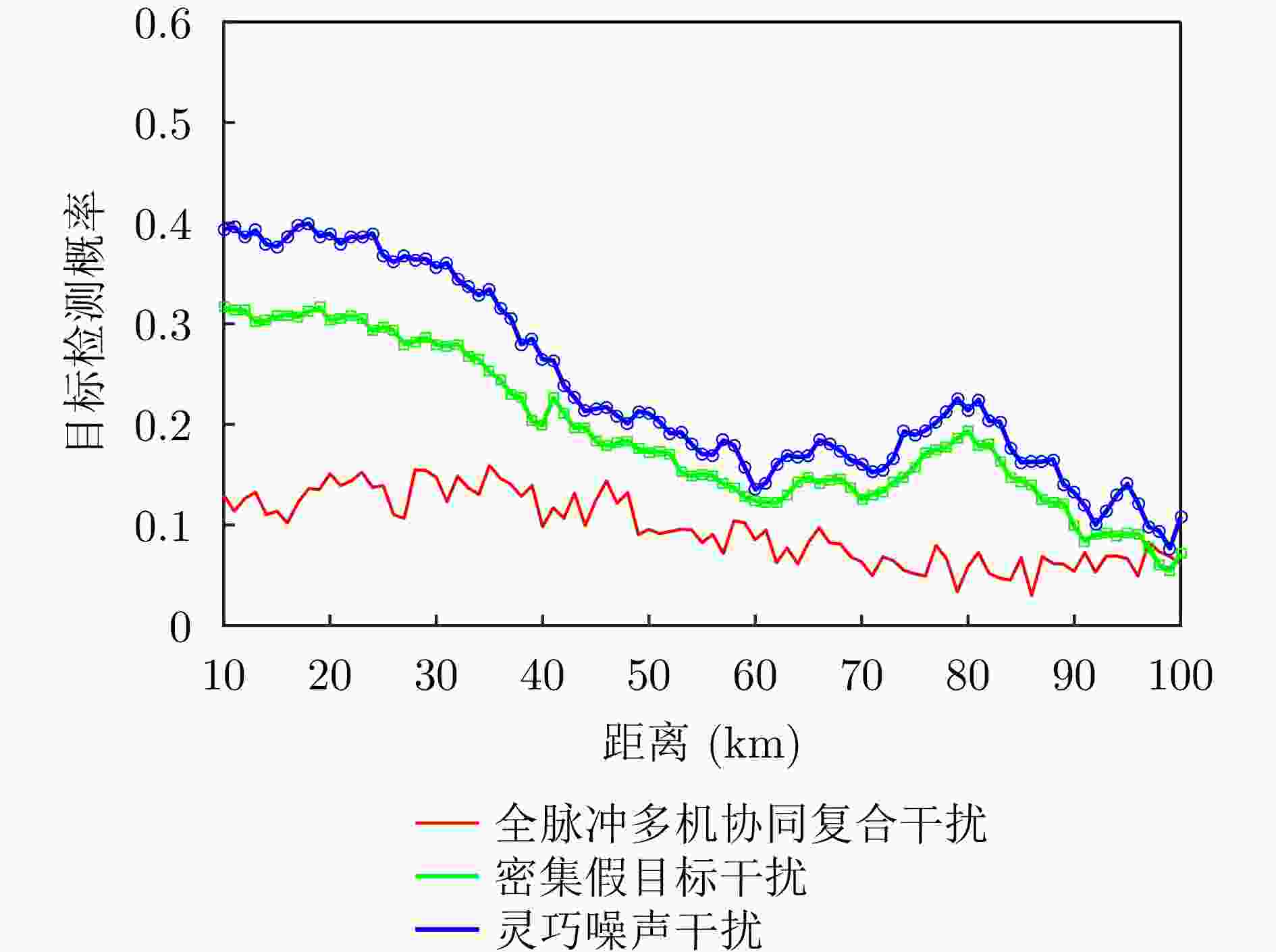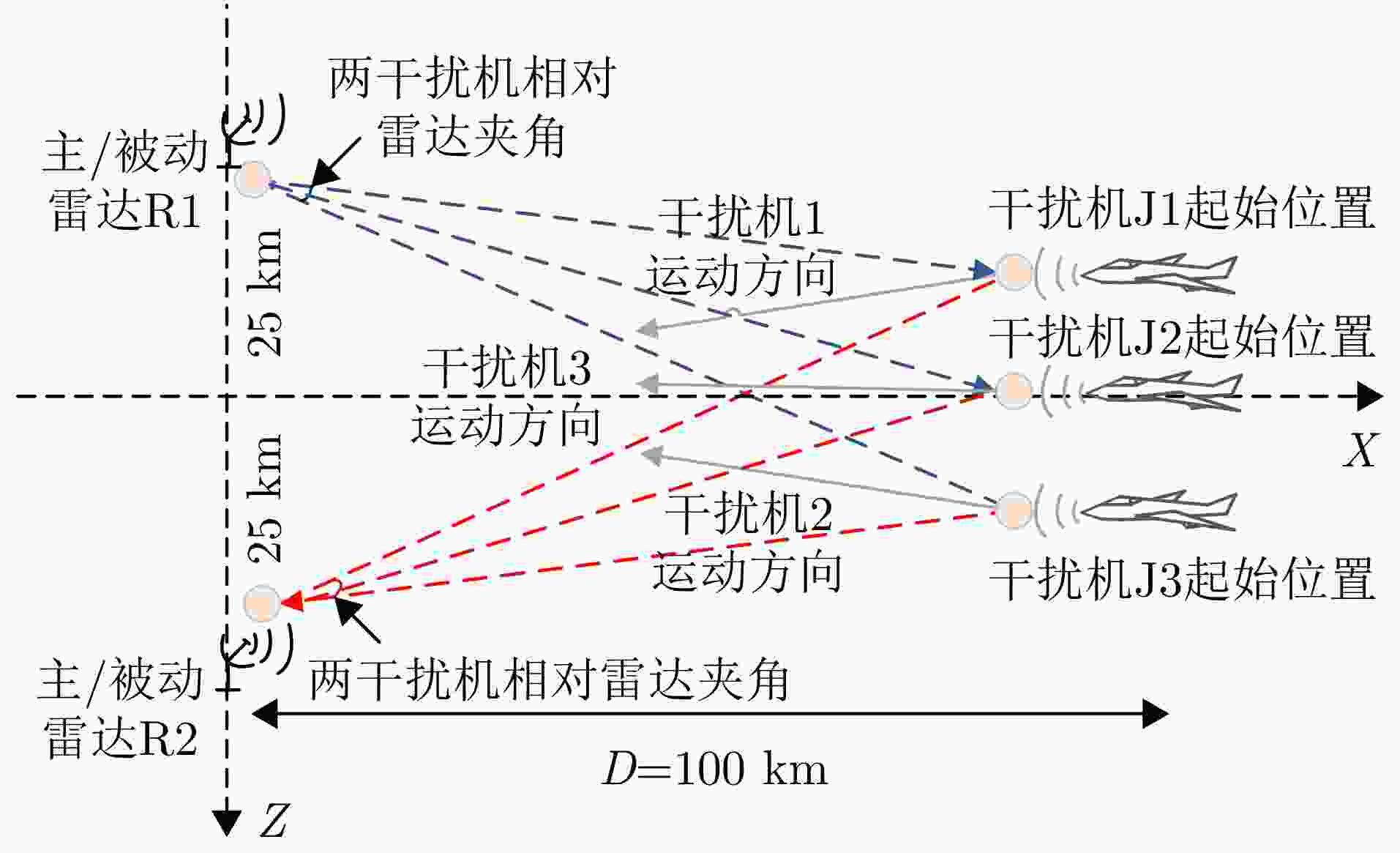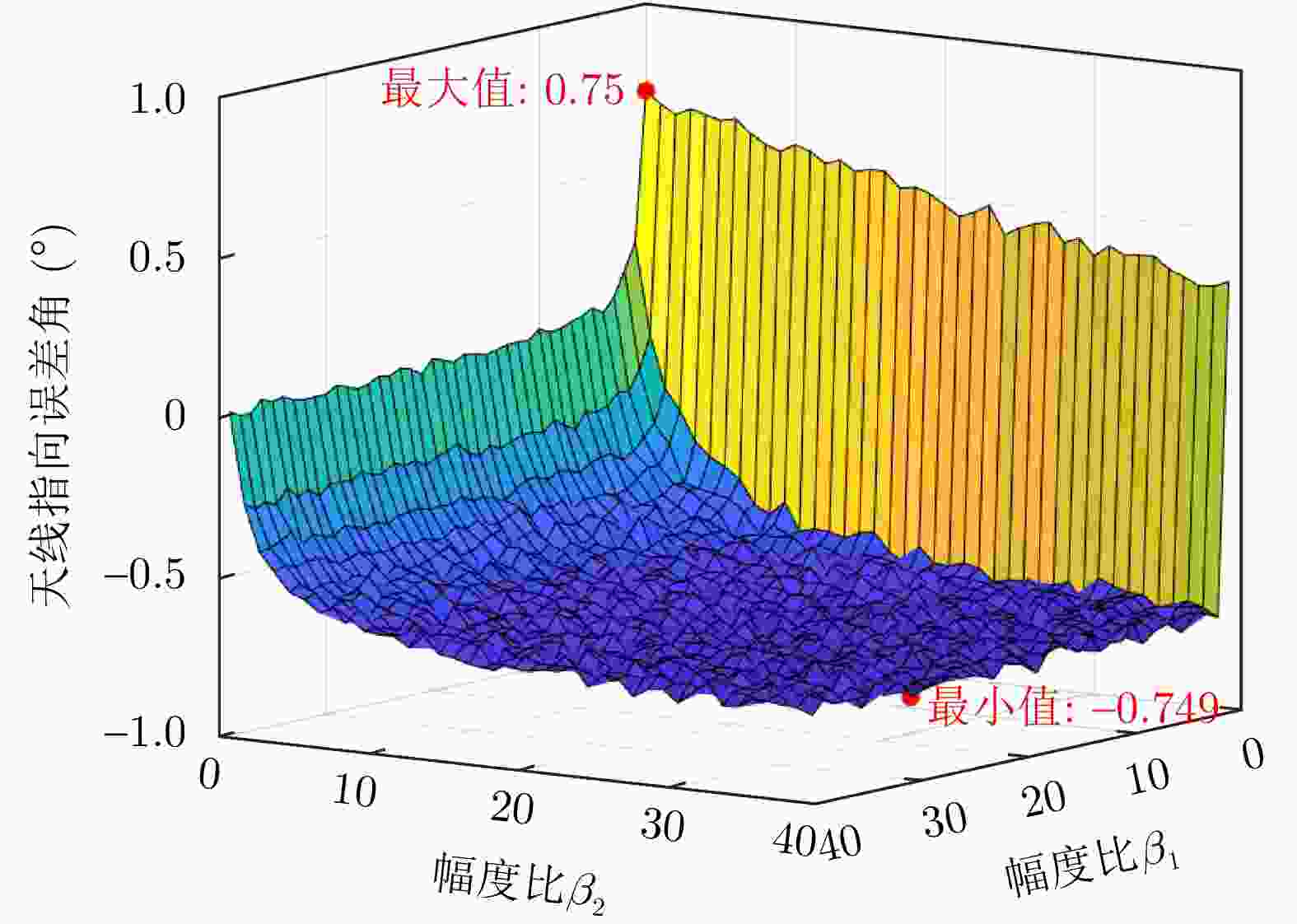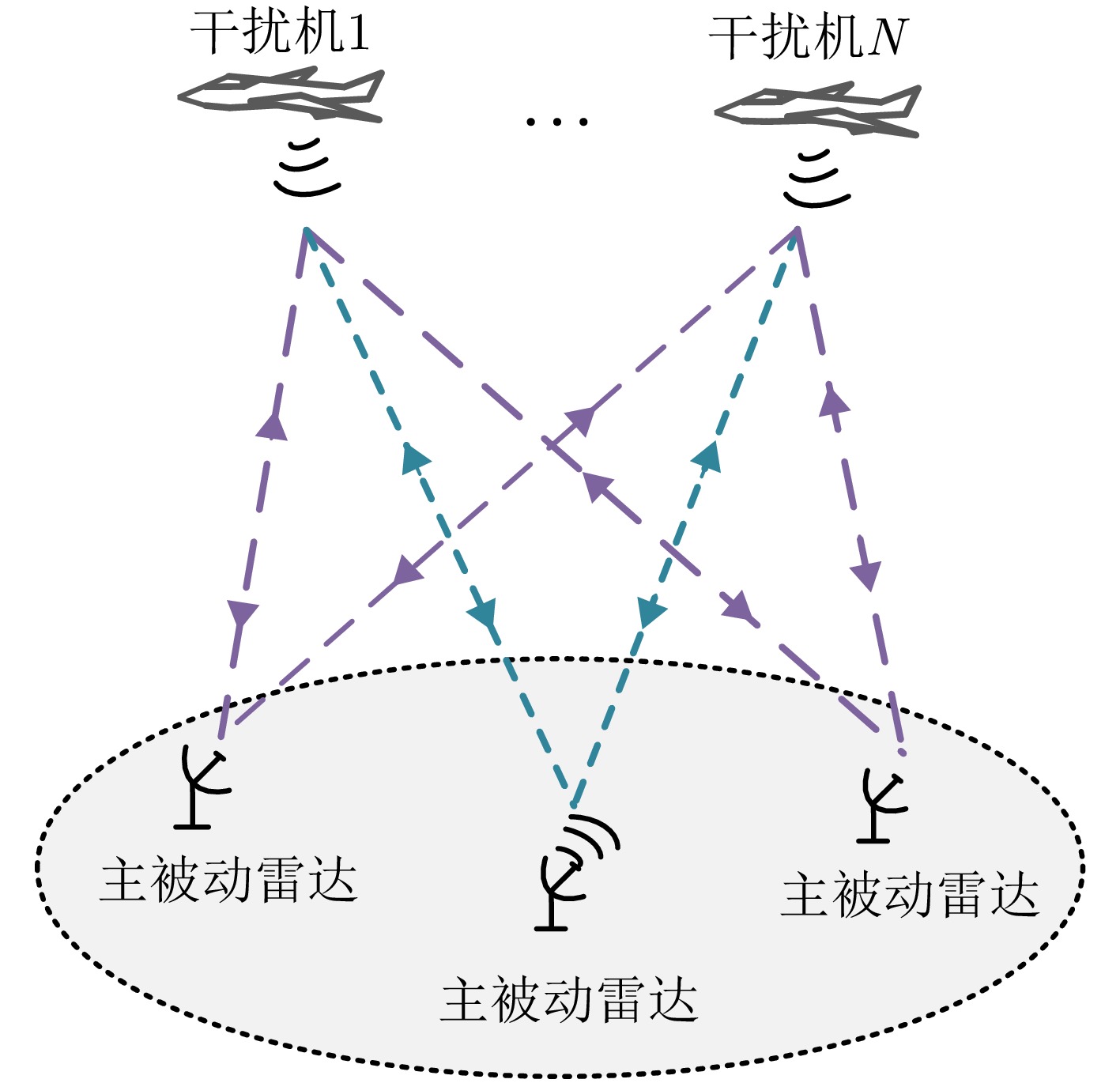Full-pulse Multi-jammer Cooperative Jamming Method for Active-passive Radar Composite Detection
-
摘要: 在日益复杂的电磁环境中,主被动雷达复合探测以其良好的优势互补性,已成为提升雷达作战能力和抗干扰能力的重要工作模式。传统的单一压制或欺骗类干扰方法仅对雷达主动或被动模式产生有效干扰,难以对主被动雷达复合探测产生良好的干扰效果。为了能够提高对主被动雷达复合探测的干扰能力,该文提出一种面向主被动雷达复合探测的全脉冲多机协同干扰方法,通过对雷达主动模式下目标的恒虚警率(CFAR)检测原理分析,利用雷达检测概率与信噪比的相关性,调整多假目标的功率序列及位置间距分布,构建全脉冲时域赋形隐蔽干扰模型,实现对雷达主动模式的有效压制;同时,通过对雷达被动模式的测向原理分析,提出一种基于多部干扰机的协同干扰策略,动态调整干扰机的发射功率,在多部干扰机间产生多个随机的欺骗角度,实现雷达被动模式的多角度欺骗效果;最后,通过上述两种策略的有机结合构建全脉冲多机协同干扰方法,实现对主被动雷达复合探测的有效干扰。实验结果表明,与传统单一压制或欺骗类干扰方法相比,该文所提全脉冲多机协同干扰方法能够有效提高雷达CFAR检测门限,降低雷达在主动模式下的检测概率;同时,在干扰机附近区域产生每一帧都不同的虚假角度,扩大角度欺骗范围,综合提升对主被动雷达复合探测的干扰性能。Abstract: In an increasingly complex electromagnetic environment, the composite detection of active-passive radar, with its excellent complementary advantages, has become an important working mode for enhancing the combat capability and anti-interference capability of radars. The traditional single suppression or deception jamming method can only produce effective jamming in active or passive radar mode, and a good jamming effect is difficult to produce on the composite detection of active-passive radar. In order to improve the jamming ability of active-passive radar composite detection, this paper proposes a full-pulse multi-jammer cooperative jamming method for active-passive radar composite detection. By analyzing the principle of Constant False Alarm Rate (CFAR) detection in radar active mode, the power series and position spacing distribution of multiple false targets is adjusted through the correlation between radar detection probability and signal-to-noise ratio, and the full-pulse time-domain rendering covert jamming model is constructed to effectively suppress the radar active mode. At the same time, by analyzing the principle of angle direction finding in radar passive mode, a cooperative jamming strategy based on multiple jammers is proposed, which dynamically adjusts the transmitting power of jammers and generates multiple random deception angles among the jammers to realize the multi-angle deception effect in radar passive mode. Finally, through the organic combination of the aforementioned two strategies, a full-pulse multi-jammer cooperative jamming method is constructed to achieve effective jamming in active-passive radar composite detection. The experimental results show that compared with the traditional single suppression or deception jamming methods, the proposed full-pulse multi-jammer cooperative jamming method can effectively increase the detection threshold of radar CFAR and, reduce the detection probability in the radar active mode. At the same time, different false angles are generated in each frame near the jammer to expand the range of angle deception, to comprehensively improve the jamming performance of active-passive radar composite detection.
-
表 1 主被动雷达参数
Table 1. Parameters of active-passive radars
参数 数值 参数 数值 发射功率$ {P_{\mathrm{t}}} $ 6 MW 信号重复周期$ {T_{\mathrm{r}}} $ 3 ms 发射增益$ {G_{\mathrm{t}}} $ 41 dB 信号脉宽$ {T_{\rm p}} $ 50 μs 载频$ {F_{\mathrm{c}}} $ 3.3 GHz 噪声系数F 3 dB 波束宽度 1.7° 噪声温度T 500 K 信号带宽B 10 MHz 虚警率$ {P_{{\mathrm{fa}}}} $ 1×10–5 信号采样率$ {F_{\mathrm{s}}} $ 20 MHz 参考单元长度N 10 表 2 干扰机参数
Table 2. Parameters of the jammers
参数 数值 参数 数值 干扰机发射功率$ {P_{\mathrm{J}}} $ 10 W 干扰机截面积$ \sigma $ 1 m2 载频$ {F_{\mathrm{c}}} $ 3.3 GHz 天线增益 10 dB 表 3 不同幅度比下欺骗角度的均值
Table 3. Mean values of deception angles under different amplitude ratios
夹角(°) 幅度比 0 1 20 50 0.5 –0.23 0 0.21 0.22 1.0 –0.49 0 0.42 0.48 1.5 –0.75 0 0.67 0.74 表 4 不同幅度比下欺骗角度的标准差
Table 4. Standard deviations of deception angles under different amplitude ratios
夹角(°) 幅度比 0 1 20 50 0.5 0.012 0.013 0.014 0.016 1.0 0.013 0.014 0.015 0.016 1.5 0.013 0.017 0.019 0.020 -
[1] 杨军, 张萌. 基于主动探测与被动截获协同的多源异类数据融合定位算法研究[J]. 电子学报, 2018, 46(10): 2467–2471. doi: 10.3969/j.issn.0372-2112.2018.10.021.YANG Jun and ZHANG Meng. Research on multi-source heterogeneous data fusion location algorithm based on active detection and passive acquisition[J]. Acta Electronica Sinica, 2018, 46(10): 2467–2471. doi: 10.3969/j.issn.0372-2112.2018.10.021. [2] 万显荣, 易建新, 占伟杰, 等. 基于多照射源的被动雷达研究进展与发展趋势[J]. 雷达学报, 2020, 9(6): 939–958. doi: 10.12000/JR20143.WAN Xianrong, YI Jianxin, ZHAN Weijie, et al. Research progress and development trend of the multi-illuminator-based passive radar[J]. Journal of Radars, 2020, 9(6): 939–958. doi: 10.12000/JR20143. [3] 易伟, 袁野, 刘光宏, 等. 多雷达协同探测技术研究进展:认知跟踪与资源调度算法[J]. 雷达学报, 2023, 12(3): 471–499. doi: 10.12000/JR23036.YI Wei, YUAN Ye, LIU Guanghong, et al. Recent advances in multi-radar collaborative surveillance: Cognitive tracking and resource scheduling algorithms[J]. Journal of Radars, 2023, 12(3): 471–499. doi: 10.12000/JR23036. [4] WU Wenhua, HAN Guojun, CAO Yunhe, et al. MIMO waveform design for radar and communication integrated system in the presence of active interferences[J]. Digital Signal Processing, 2022, 129: 103685. doi: 10.1016/j.dsp.2022.103685. [5] LIU Tianpeng, LIAO Dongping, WEI Xizhang, et al. Performance analysis of multiple-element retrodirective cross-eye jamming based on linear array[J]. IEEE Transactions on Aerospace and Electronic Systems, 2015, 51(3): 1867–1876. doi: 10.1109/TAES.2015.140035. [6] 万显荣, 吕敏, 谢德强,等. 基于信号结构特点的外源雷达干扰方法研究[J]. 雷达学报, 2020, 9(6): 987–997. doi: 10.12000/JR20124.WAN Xianrong, LYU Min, XIE Deqiang, et al. Jamming method of passive radar systems based on characteristics of signal structure[J]. Journal of Radars, 2020, 9(6): 987–997. doi: 10.12000/JR20124. [7] ZHANG Yupei, ZHAO Zhijin, and Bu Yi. Radar active jamming recognition under open world setting[J]. Remote Sensing, 2023, 15(16): 4107. doi: 10.3390/rs15164107. [8] 陈伯孝. 现代雷达系统分析与设计[M]. 西安: 西安电子科技大学出版社, 2012: 241–256, 269–271, 287–296.CHEN Baixiao. Mordern Radar System Analysis and Design[M]. Xi’an: Xidian University Press, 2012: 241–256, 269–271, 287–296. [9] 赵燕慧, 汤建龙, 李骥阳, 等. 对降维STAP机载雷达的延时混叠转发干扰方法分析[J]. 系统工程与电子技术, 2020, 42(8): 1718–1725. doi: 10.3969/j.issn.1001-506X.2020.08.11.ZHAO Yanhui, TANG Jianlong, LI Jiyang, et al. Analysis of time-delay aliasing transmission jamming method for reduced dimension STAP airborne radar[J]. Systems Engineering and Electronics, 2020, 42(8): 1718–1725. doi: 10.3969/j.issn.1001-506X.2020.08.11. [10] 周超, 刘泉华, 胡程. 间歇采样转发式干扰的时频域辨识与抑制[J]. 雷达学报, 2019, 8(1): 100–106. doi: 10.12000/JR18080.ZHOU Chao, LIU Quanhua, and HU Cheng. Time-frequency analysis techniques for recognition and suppression of interrupted sampling repeater jamming[J]. Journal of Radars, 2019, 8(1): 100–106. doi: 10.12000/JR18080. [11] 王雪松, 刘建成, 张文明, 等. 间歇采样转发干扰的数学原理[J]. 中国科学E辑: 信息科学, 2006, 36(8): 891–901. doi: 10.1360/zf2006-36-8-891.WANG Xuesong, LIU Jiancheng, ZHANG Wenming, et al. Mathematic principles of interrupted-sampling repeater jamming (ISRJ)[J]. Science in China Series E: Information Science, 2006, 36(8): 891–901. doi: 10.1360/zf2006-36-8-891. [12] FENG Dejun, TAO Huamin, YANG Yong, et al. Jamming de-chirping radar using interrupted-sampling repeater[J]. Science China Information Sciences, 2011, 54(10): 2138–2146. doi: 10.1007/s11432-011-4431-4. [13] WEI Jingyi, LI Yachao, YANG Rui, et al. A nonuniformly distributed multi-pulse coded waveform to combat azimuth interrupted sampling repeater jamming in SAR[J]. IEEE Transactions on Aerospace and Electronic Systems, 2023, 59(6): 9054–9066. doi: 10.1109/TAES.2023.3313104. [14] 潘小义, 王伟, 冯德军, 等. 基于全脉冲分段转发的LFM雷达干扰方法[J]. 国防科技大学学报, 2013, 35(3): 119–125. doi: 10.3969/j.issn.1001-2486.2013.03.021.PAN Xiaoyi, WANG Wei, FENG Dejun, et al. Repeat jamming against LFM radars based on pulse separation[J]. Journal of National University of Defense Technology, 2013, 35(3): 119–125. doi: 10.3969/j.issn.1001-2486.2013.03.021. [15] 刘峥, 沈福民, 张守宏. 单脉冲跟踪雷达抗距离欺骗干扰方法[J]. 西安电子科技大学学报, 1997, 24(S1): 82–87.LIU Zheng, SHEN Fumin, and ZHANG Shouhong. A study of a mono-pulse radar to counter the range cheat jamming[J]. Journal of Xidian University, 1997, 24(S1): 82–87. [16] CHEN Yang, TIAN Bo, WANG Chunyang, et al. Improved MUSIC method against range dimension deceptive jamming based on FDA-MIMO[J]. Applied Sciences. 2022, 12(22): 11695. doi. 10.3390/app122211695. [17] 王琪, 廖志忠, 燕飞. 基于概率数据关联的雷达导引头抗速度拖引干扰算法[J]. 系统工程与电子技术, 2022, 44(2): 448–454. doi: 10.12305/j.issn.1001-506X.2022.02.12.WANG Qi, LIAO Zhizhong, and YAN Fei. Algorithm for countering velocity gate pull-off jamming of radar seeker based on probability data association[J]. Systems Engineering and Electronics, 2022, 44(2): 448–454. doi: 10.12305/j.issn.1001-506X.2022.02.12. [18] 李永祯, 胡万秋, 程旭, 等. 相干两点源角欺骗干扰的极化鉴别方法研究[J]. 兵工学报, 2013, 34(9): 1078–1083. doi: 10.3969/j.issn.1000-1093.2013.09.004.LI Yongzhen, HU Wanqiu, CHENG Xu, et al. Research on polarization discrimination algorithm for coherent dual-source angle deception interference[J]. Acta Armamentarii, 2013, 34(9): 1078–1083. doi: 10.3969/j.issn.1000-1093.2013.09.004. [19] PIETERSE F P and DU PLESSIS W P. Implementation and testing of a retrodirective cross-eye jammer[J]. IEEE Transactions on Aerospace and Electronic Systems, 2022, 58(5): 4486–4494. doi: 10.1109/TAES.2022.3164017. [20] 黄大通, 邢世其, 徐伟, 等. 对多通道SAR欺骗干扰抑制的多干扰机协同调幅对抗方法[J]. 电子学报, 2023, 51(9): 2301–2312. doi: 10.12263/DZXB.20211247.HUANG Datong, XING Shiqi, XU Wei, et al. A cooperative countermeasure of multiple jammers against multi-channel SAR deception jamming suppression based on amplitude modulation[J]. Acta Electronica Sinica, 2023, 51(9): 2301–2312. doi: 10.12263/DZXB.20211247. [21] ZHANG Wenxu, ZHAO Tong, ZHAO Zhongkai, et al. Performance analysis of deep reinforcement learning-based intelligent cooperative jamming method confronting multi-functional networked radar[J]. Signal Processing, 2023, 207: 108965. doi: 10.1016/j.sigpro.2023.108965. [22] LIU Feilong, ZHU Shengqi, XU Jingwei, et al. Fast repeater deception jamming suppression with DFI-FDA-MIMO radar[J]. IEEE Transactions on Aerospace and Electronic Systems, 2024, 60(4): 4271–4284. doi: 10.1109/TAES.2024.3374711. [23] ZHOU Changlin, WANG Chunyang, GONG Jian, et al. Phase characteristics and angle deception of frequency-diversity-array-transmitted signals based on time index within pulse[J]. Remote Sensing, 2023, 15(21): 5171. doi 10.3390/rs15215171. [24] BANG Huang, WANG Wenqin, ZHANG Shunsheng, et al. FDA-based space-time-frequency deceptive jamming against SAR imaging[J]. IEEE Transactions on Aerospace and Electronic Systems, 2022, 58(3): 2127–2140. doi: 10.1109/TAES.2021.3130212. [25] 解烽, 刘环宇, 胡锡坤, 等. 基于复数域深度强化学习的多干扰场景雷达抗干扰方法[J]. 雷达学报, 2023, 12(6): 1290–1304. doi: 10.12000/JR23139.XIE Feng, LIU Huanyu, HU Xikun, et al. A radar anti-jamming method under multi-jamming scenarios based on deep reinforcement learning in complex domains[J]. Journal of Radars, 2023, 12(6): 1290–1304. doi: 10.12000/JR23139. [26] BACHMANN D J, EVANS R J, and MORAN B. Game theoretic analysis of adaptive radar jamming[J]. IEEE Transactions on Aerospace and Electronic Systems, 2011, 47(2): 1081–1100. doi: 10.1109/TAES.2011.5751244. [27] 吴兆东, 胡生亮, 罗亚松, 等. 舷外有源诱饵对雷达末制导目标定位的干扰动态分析[J]. 电子科技大学学报, 2023, 52(5): 709–717. doi: 10.12178/1001-0548.2022282.WU Zhaodong, HU Shengliang, LUO Yasong, et al. Dynamic analysis of outboard active decoy jamming on target location of terminal radar guidance[J]. Journal of University of Electronic Science and Technology of China, 2023, 52(5): 709–717. doi: 10.12178/1001-0548.2022282. [28] 马佳智, 施龙飞, 徐振海, 等. 单脉冲雷达多点源参数估计与抗干扰技术进展[J]. 雷达学报, 2019, 8(1): 125–139. doi: 10.12000/JR18093.MA Jiazhi, SHI Longfei, XU Zhenhai, et al. Overview of multi-source parameter estimation and jamming mitigation for monopulse radars[J]. Journal of Radars, 2019, 8(1): 125–139. doi: 10.12000/JR18093. [29] 丁鹭飞, 耿富禄, 陈建春. 雷达原理[M]. 北京: 电子工业出版社, 2020: 180–182.DING Lufei, GENG Fulu, and CHEN Jianchun. Principle of Radar[M]. Beijing, Publishing House of Electronics Industry, 2020: 180–182. -



 作者中心
作者中心 专家审稿
专家审稿 责编办公
责编办公 编辑办公
编辑办公
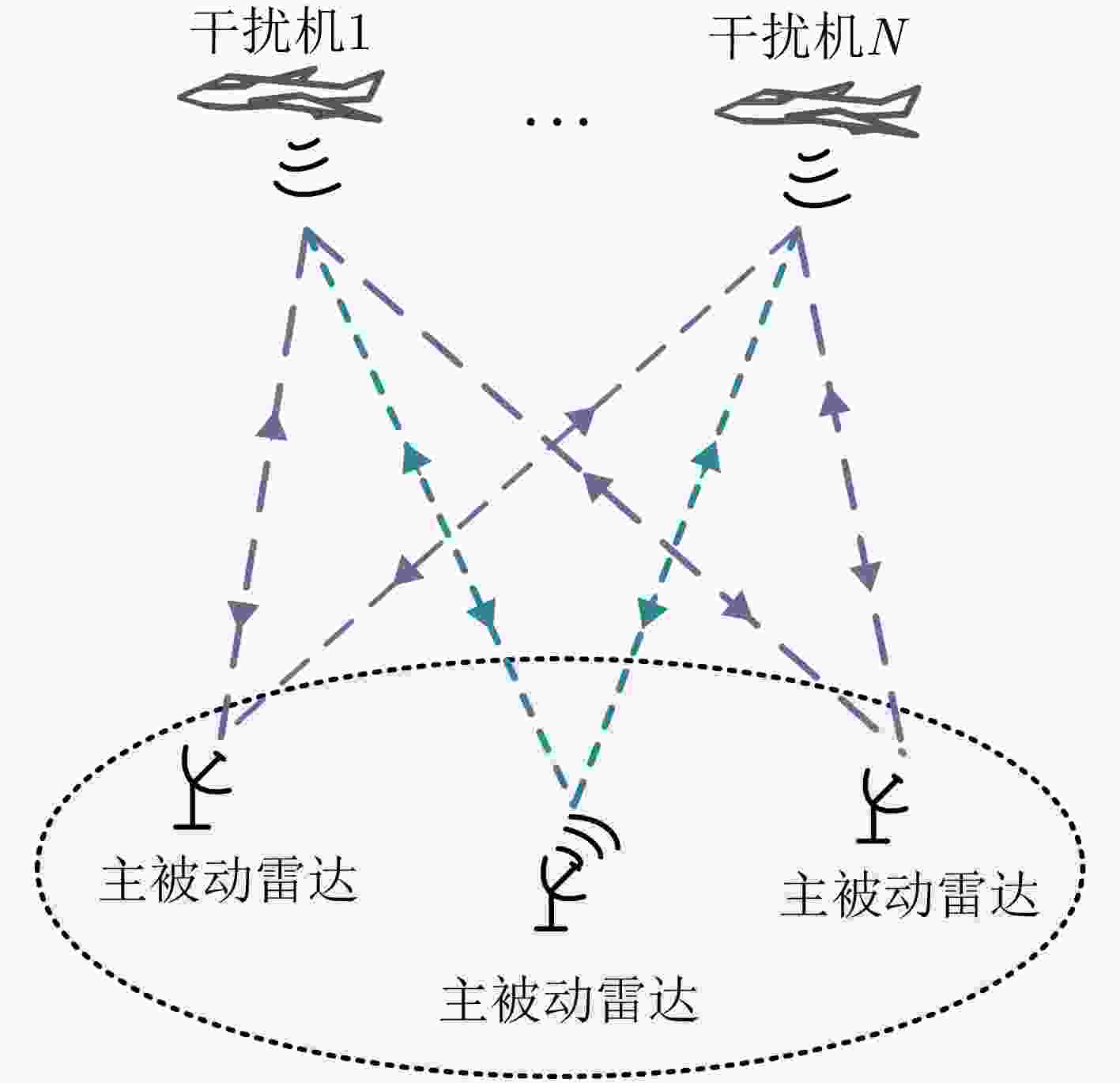
 下载:
下载:





